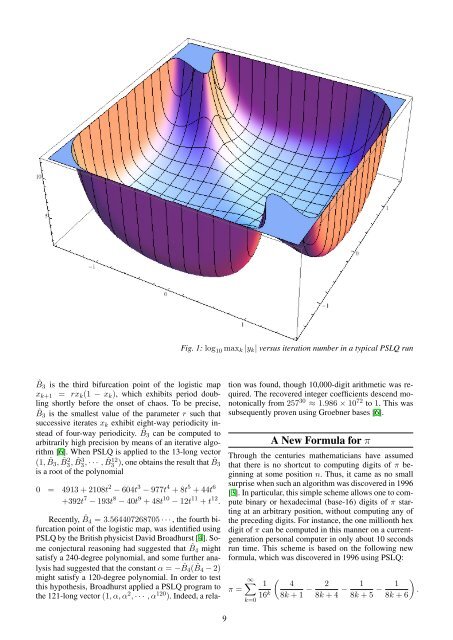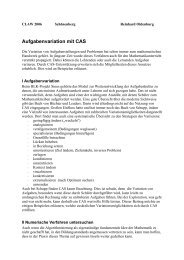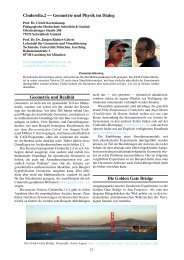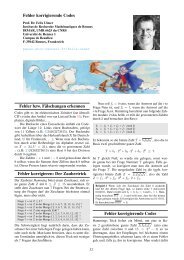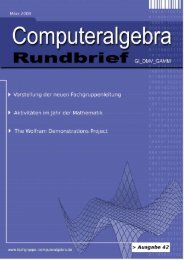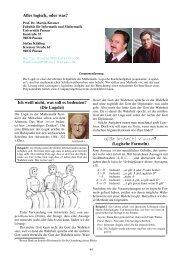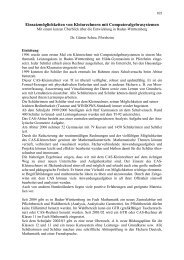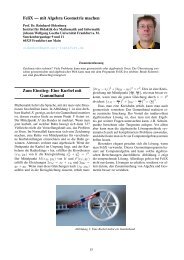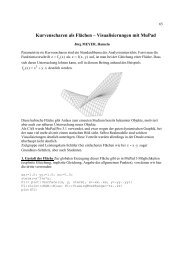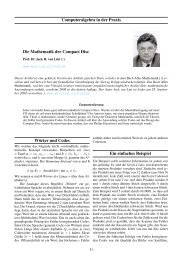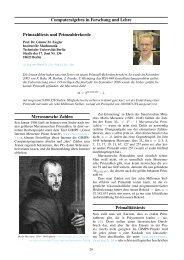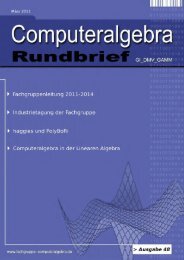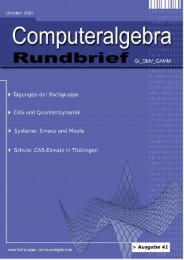Mathematica - Fachgruppe Computeralgebra
Mathematica - Fachgruppe Computeralgebra
Mathematica - Fachgruppe Computeralgebra
Sie wollen auch ein ePaper? Erhöhen Sie die Reichweite Ihrer Titel.
YUMPU macht aus Druck-PDFs automatisch weboptimierte ePaper, die Google liebt.
ˆB3 is the third bifurcation point of the logistic map<br />
xk+1 = rxk(1 − xk), which exhibits period doubling<br />
shortly before the onset of chaos. To be precise,<br />
ˆB3 is the smallest value of the parameter r such that<br />
successive iterates xk exhibit eight-way periodicity instead<br />
of four-way periodicity. ˆ B3 can be computed to<br />
arbitrarily high precision by means of an iterative algorithm<br />
[6]. When PSLQ is applied to the 13-long vector<br />
(1, ˆ B3, ˆ B2 3 , ˆ B3 3 , · · · , ˆ B12 3 ), one obtains the result that ˆ B3<br />
is a root of the polynomial<br />
0 = 4913 + 2108t 2 − 604t 3 − 977t 4 + 8t 5 + 44t 6<br />
+392t 7 − 193t 8 − 40t 9 + 48t 10 − 12t 11 + t 12 .<br />
Recently, ˆ B4 = 3.564407268705 · · · , the fourth bifurcation<br />
point of the logistic map, was identified using<br />
PSLQ by the British physicist David Broadhurst [4]. Some<br />
conjectural reasoning had suggested that ˆ B4 might<br />
satisfy a 240-degree polynomial, and some further analysis<br />
had suggested that the constant α = − ˆ B4( ˆ B4 − 2)<br />
might satisfy a 120-degree polynomial. In order to test<br />
this hypothesis, Broadhurst applied a PSLQ program to<br />
the 121-long vector (1, α, α 2 , · · · , α 120 ). Indeed, a rela-<br />
Fig. 1: log 10 maxk |yk| versus iteration number in a typical PSLQ run<br />
9<br />
tion was found, though 10,000-digit arithmetic was required.<br />
The recovered integer coefficients descend monotonically<br />
from 257 30 ≈ 1.986 × 10 72 to 1. This was<br />
subsequently proven using Groebner bases [6].<br />
A New Formula for π<br />
Through the centuries mathematicians have assumed<br />
that there is no shortcut to computing digits of π beginning<br />
at some position n. Thus, it came as no small<br />
surprise when such an algorithm was discovered in 1996<br />
[3]. In particular, this simple scheme allows one to compute<br />
binary or hexadecimal (base-16) digits of π starting<br />
at an arbitrary position, without computing any of<br />
the preceding digits. For instance, the one millionth hex<br />
digit of π can be computed in this manner on a currentgeneration<br />
personal computer in only about 10 seconds<br />
run time. This scheme is based on the following new<br />
formula, which was discovered in 1996 using PSLQ:<br />
π =<br />
∞<br />
k=0<br />
1<br />
16k <br />
4 2 1 1<br />
− − − .<br />
8k + 1 8k + 4 8k + 5 8k + 6


